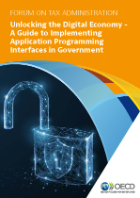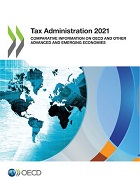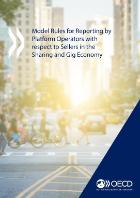Personal income tax
Personal income taxes (PIT) account for more than 20% of total tax revenue (including social security contributions) collected across OECD countries and they are also a key source of revenue in non-OECD countries.
To support overall compliance, many administrations have introduced withholding and reporting regimes for aspects of PIT that form part of compliance-by-design approaches, in particular for salaried employees through Pay-As-You-Earn (PAYE) approaches. (See here which jurisdiction have such PAYE regimes.) The importance of such data reporting and tax withholding regimes can be seen in tax gap analyses for PIT where for salary and wage income the tax gap is very low. This is different for other income subject to PIT which rely on self-reporting by the taxpayer (voluntary compliance). In these cases, the tax gap is often much greater as a result of errors, omissions due to lack of care or knowledge, or due to deliberate non-compliance.
In order to help address tax gaps where there is a reliance on voluntary compliance, administrations are:
- Expanding third party data reporting and withholding regimes beyond employers to cover financial intermediaries and other stakeholders, including the data sharing between tax administrations and other parts of government. Click here see to which jurisdictions have withholding regimes for income of residents and non-residents, and reporting regimes for income of residents and non-residents.
- Enhancing risk assessment through the incorporation of a greater range of data sources and, in some cases, through the use of artificial intelligence (AI).
- Improving online services to make it easier for taxpayers to understand their tax obligations, to interact with the tax administration and to report taxable income, including through the use of digital identities to expand the range of secure self-service options.
Expanding third party data reporting and withholding regimes
In addition to long established PAYE approaches, tax administrations are now also expanding third party data reporting and withholding regimes to other areas such as collecting data (and withholding taxes) on interest, dividend and royalty income. As well as building-in compliance, these reporting and withholding regimes can significantly reduce burdens for large numbers of taxpayers depending on the extent of taxpayer involvement in any post-payment adjustments that might be needed (i.e. where withholding results in under-payment or over-payment of tax). In place of self-reporting and paying, the withholding taxes are paid directly to the tax administration, usually by a principal who pays the net income to the recipient (for example withholding by an employer on salary paid to an employee), or by an intermediary between the payer and customer).
Equipped with all this data, many tax administrations are also introducing new services, for example the prefilling of tax returns. Prefilling of returns can significantly reduce the compliance burden of taxpayers, and many administrations are now looking to include data on deductible expenses to allow for a full pre-filling of PIT returns.
Data collection and prefilling for PIT returns
Note: To understand fully the information included in this map, users are advised to look at the source data tables and the original survey question as some of the self-reported data may not give the full picture and may need to be looked at in the wider context of the survey.
At a global level international organisations, such as the OECD, develop standards that help making data visible to tax administration including in the cross border context. This includes, for example, the Standard for Automatic Exchange of Financial Account Information in Tax Matters or the Model Rules for Reporting by Platform Operators with respect to Sellers in the Sharing and Gig Economy.
Enhancing risk assessment
The vast amounts of data that tax administrations receive is used to review taxpayer reported information through tax audits, automated electronic checks, validations and matching of taxpayer information. The undertaking and visibility of these and other compliance actions is critical in supporting voluntary compliance, including through their impacts on perceptions of fairness in the tax system. The increased availability of data also allows for a sharpened targeting of risks and future trend analysis, and with increasing digitalisation, even more tax related data from taxpayers and third parties will become available in the future. To process and manage this data, many tax administrations apply data sciences techniques and use analytical tools. Often, sophisticated analysis is being combined with behavioural analysis to build a more complete picture of compliance risks and administrations have started using AI for risk assessment purposes and the detection of tax evasion and fraud.
Administrations that use AI in PIT risk assessment processes
Note: To understand fully the information included in this map, users are advised to look at the source data tables and the original survey question as some of the self-reported data may not give the full picture and may need to be looked at in the wider context of the survey.
Source: Table TRM3
Click on Data Management for more information on how administrations manage their data, including data collection, data sharing and data analytics; or Tax Rule Management for how administrations use technology for tax rule management.
Improving online services
Tax administrations are dealing with a massive number of individual taxpayers and that building a voluntary compliance culture requires the provision of a wide range of effective and easy to use taxpayer communication and service channels, both on a reactive and proactive basis, as well as programmes to assist and educate taxpayers with meeting their tax obligations. As regards communication, often these have been delivered on a one-to-many basis, such as the provision of guidance or reminders as well as calculation and reporting tools. However, the use of innovative tools allows communications to become more personalised to the taxpayer’s individual circumstances, to be delivered via an increasing range of communication channels and to facilitate the drive towards self-service.
With an increase in taxpayer expectations, the self-service offering from tax administrations is growing, and there is an expanding range of self-services being provided. Common examples of this include the ability to register, file and pay online, along with a range of interactive tools. This is leading to efficiency gains in tax administrations, as well as being able to provide a more 24/7-style service to taxpayers.
Personal income tax: Online services provided by tax administrations
Note: To understand fully the information included in this map, users are advised to look at the source data tables and the original survey question as some of the self-reported data may not give the full picture and may need to be looked at in the wider context of the survey.
Source: Table TT1
Those services are now expanded further by using innovative technologies, such as artificial intelligence (AI). For example, a growing number of tax administrations reports using AI in virtual assistants to help respond to taxpayer enquiries and support self-service (see map below).
Administrations that have developed virtual assistants to respond to taxpayer queries
Note: To understand fully the information included in this map, users are advised to look at the source data tables and the original survey question as some of the self-reported data may not give the full picture and may need to be looked at in the wider context of the survey.
Source: Table TT5
Click here for more about the provision of online services by tax administrations, the (co-)creation of software packages or the development of application programming interfaces (APIs): Taxpayer Touchpoints.
To allow the secure identification of taxpayers when interacting with the tax administration through digital means, tax administrations started creating unique digital identities of taxpayers. This allows taxpayers to access a range of digital services, for example, through taxpayer portals. The map below shows the usage of digital identities by individual taxpayers to access secure digital services offered by tax administrations. Click on the Digital Identity page for more information on the use of digital identities by tax administrations, including the characteristics, authentication and authorisation processes.
Percentage of individual taxpayers that use an approved digital identity to access secure digital services offered by the tax administration
Note: To understand fully the information included in this map, users are advised to look at the source data tables and the original survey question as some of the self-reported data may not give the full picture and may need to be looked at in the wider context of the survey.
Source: Table DI1
Further information
|
Tax Administration Series: Comparative Information on OECD and Other Advanced and Emerging Economies |
Standard for Automatic Exchange of Financial Account Information in Tax Matters |
|||
|
|
|
|
|
Related Documents






